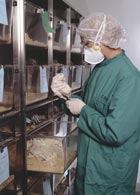

Sprachen:


There are several ways to reduce the use of non-human primates (NHPs) in research areas where no replacement can yet be foreseen.
In addition, there should be clear information available on how many animals of each species are used for experimentation, on the types of tests involved and on the reasons behind the choice of animal species and number of animals used. More...

This summary is free and ad-free, as is all of our content. You can help us remain free and independant as well as to develop new ways to communicate science by becoming a Patron!